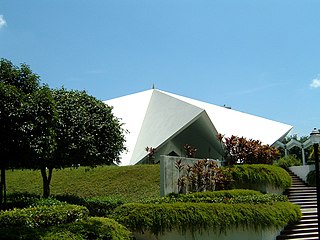
Tun Haji Abdul Razak bin Dato' Haji Hussein was a Malaysian lawyer and politician who served as the second prime minister of Malaysia from 1970 until his death in 1976. He also served as the first deputy prime minister of Malaysia from 1957 to 1970. He is referred to as the Father of Development.

Tun Hussein bin Dato' Onn was a Malaysian lawyer and politician who served as the third Prime Minister of Malaysia from the death of his predecessor Abdul Razak Hussein in 1976 to his retirement in 1981. Moreover, he was the Member of Parliament (MP) for Sri Gading from 1974 to 1981, representing Barisan Nasional (BN) and United Malays National Organisation (UMNO). He was granted the soubriquet Father of Unity.
This article lists important figures and events in Malayan public affairs during the year 1960, together with births and deaths of significant Malayans.

This article lists important figures and events in Malayan and Malaysian public affairs during the year 1963, together with births and deaths of significant Malaysians. The Federation of Malaya merged with Singapore, North Borneo, and Sarawak to form the Federation of Malaysia on 16 September.

This article lists important figures and events in Malaysian public affairs during the year 1973, together with births and deaths of notable Malaysians.
This article lists important figures and events in Malaysian public affairs during the year 1974, together with births and deaths of notable Malaysians.
This article lists important figures and events in Malayan public affairs during the year 1955, as well as births and deaths of significant Malayans.
This article lists important figures and events in Malayan public affairs during the year 1954, as well as births and deaths of significant Malayans.

The Malaysian Prison Department, is a department controlled by the Malaysian Minister of Home Affairs responsible for prisons where offenders sentenced by the courts are held. These jails also act as detention and recovery institutions.
Liga Semi-Pro was a semi-pro football league in Malaysia that operated from 1989 until 1993. The league was managed by Football Association of Malaysia. It consist of two divisions, the Liga Semi-Pro Divisyen 1 and Liga Semi-Pro Divisyen 2. Liga Semi-Pro was official established in 1989 as a semi-pro league competition for football team in Malaysia to qualify for Piala Malaysia.
Liga Perdana 1 or Liga Perdana Satu was the nation's top-tier professional football league in Malaysia that operated from 1998 to 2003.

Sultan Nazrin Muizzuddin Shah ibni Almarhum Sultan Azlan Muhibbuddin Shah Al-Maghfur-Lah is the Deputy Yang di-Pertuan Agong of Malaysia since December 2016 and the 35th Sultan of Perak since ascending to the throne in May 2014.
The 2016 Malaysia FA Cup was the 27th season of the Malaysia FA Cup, a knockout competition for Malaysia's state football association and clubs. It was sponsored by Kopi Superbest Power, and was known as the Superbest Power Piala FA due to sponsorship purposes. LionsXII were the defending champions after beating Kelantan 3–1 in the previous season, but did not compete in this edition.
Liga Malaysia was an amateur football league in Malaysia that operated from 1982 until 1988. The league was managed by the Football Association of Malaysia. The Malaysian League was established in 1982 after the introduction of a league trophy for the winner of the league stage qualification round for the Malaysia Cup, with the format first introduced in 1979 where the top eight teams qualified from the league to compete in the knockout stages of the Malaysia Cup.
This article lists important figures and events in the public affairs of British Malaya during the year 1947, together with births and deaths of prominent Malayans. As the Malayan Union, Malaya was a British colony.
This article lists important figures and events in the public affairs of British Malaya during the year 1940, together with births and deaths of prominent Malayans.
Liga Semi-Pro Divisyen 1 was the top-tier semi-pro football league in Malaysia that operated from 1989 until 1993. The league was managed by Football Association of Malaysia. Liga Semi-Pro was official established in 1989 as a semi-pro league competition for football team in Malaysia to qualify for Piala Malaysia.

The Minangkabau Malaysians are citizens of the Malaysia whose ancestral roots are from Minangkabau of central Sumatra. This includes people born in the Malaysia who are of Minangkabau origin as well as Minangkabau who have migrated to Malaysia. Today, Minangkabau comprise about 989,000 people in Malaysia, and Malaysian law considers most of them to be Malays. They are majority in urban areas, which has traditionally had the highest education and a strong entrepreneurial spirit. The history of the Minangkabau migration to Malay peninsula has been recorded to have lasted a very long time. When the means of transportation were still using the ships by down the rivers and crossing the strait, many Minang people migrated to various regions such as Negeri Sembilan, Malacca, Penang, Kedah, Perak, and Pahang. Some scholars noted that the arrival of the Minangkabau to the Malay Peninsula occurred in the 12th century. This ethnic group moved in to peninsula at the height of the Sultanate of Malacca, and maintains the Adat Perpatih of matrilineal kinships system in Negeri Sembilan and north Malacca.






















